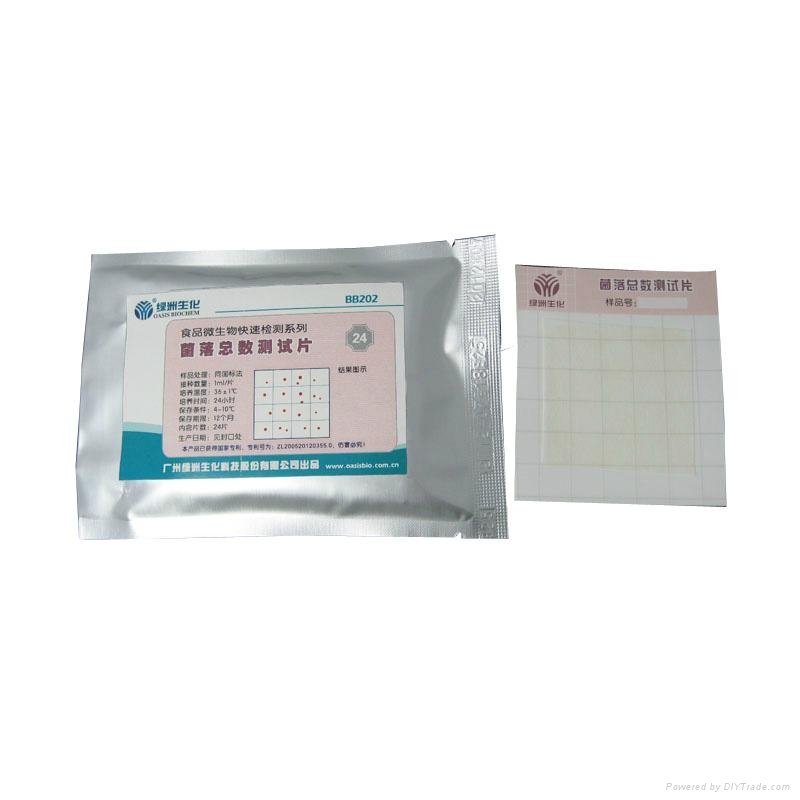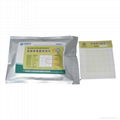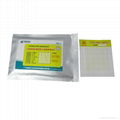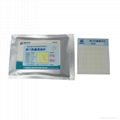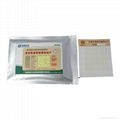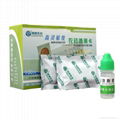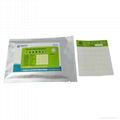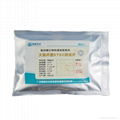| Model: | BB202 |
|---|---|
| Brand: | Oasis |
| Origin: | Made In China |
| Category: | Industrial Supplies / Other Industrial Supplies |
| Label: | count plate , bacteria colony , food safety |
| Price: |
US $17.5
/ pc
|
| Min. Order: | 1 pc |
Product Description
1. Principle&application scope
Bacteria colony count plate which is commonly used as testing index of microorganism test items, can determine the total bacterial number in unit area through certain culture condition. Bacteria colony count plate contains nutrient medium, soluble water absorbent gel, and dehydrogenase indicator (TCC), and colony shows red on count plate. This product is suitable for rapid detection of total bacterial number in all kinds of food and food material; also it is suitable to detect total bacterial number on the surface of food material, utensils and instruments.
Executive standard: Food safety national standard, food microbiology testing bacteria colony (GB 4789.2)
2. Using method
2.1 Sample preparation: Prepare the 1:10 solution by placing 25g or 25mL sample into 225mL sterile saline, then, prepare 1:100 solution by sucking1mL solution(1:10) with sterile pipette into 9mL sterile saline, and so on to prepare solution of different dilution ratio. If necessary, use 1 mol/L NAOH or 1 mol/L HCL to adjust the PH to 6.6-7.2.
2.2 Inoculation: Select 2 or 3 dilute ratio sample solution for ordinary food, while for the liquid solution which has little bacteria directly suck raw liquid to do the test. Place the bacteria colony count plate onto sterile experiment table, uncover the film on the surface. Suck 1mL solution with sterile pipette, and then drop it slowly and evenly on the count plate .Then cover the film gently and stand it for 10s to let the medium solidify. Inoculate two count plates for each dilute ratio. At the same time do a blank control.
2.3 Culture: Superimpose the count plates together and place them back to the original package and seal the package well. Place the package in the incubator with the transparent side up. The quantity of superimposed count plates is no more than 12 pieces. For ordinary food, the temperature of culture should be 36℃±1℃and time of culture should be 15-24 hours. While for aquatic food, the temperature of culture should be 30℃±1℃, and the time of culture should be 48h.
3 Results
Colony shows red spot on bacteria colony count plate. Count the colony number by choosing the plate which contain the 30~300 colonies, and then multiply it by dilution multiple as result data.
4 Counting method
4.1 If there is only one dilution ratio count plates on which the colonies are between 30CFU and 300CFU, multiply the average value of the colonies on them by the corresponding dilution multiple as the result data that the total colony quantity in every mililiter or every gram sample.
4.2 If the quantity of two serial different dilution ratios are both between 30CFU and 300CFU, calculate the average colonies by below formula
N= ∑C/ [(n1+0.1n2)d]
N in the formula means the bacteria quantity of the sample
∑C means the total quantity of bacteria which is between 30CFU and 300CFU on these two serial different diluting ratio count plates.
n1 means the quantity of count plate of which the dilution multiple is lower between two serial different dilute multiples.
n2 means the quantity of count plate of which the dilution multiple is larger between two serial different dilution multiples..
d means the higher dilution ratio between two serial different ratios.
4.3 If the bacteria quantity of all the dilute ratio sample solution is more than 300CFU, count the bacteria quantity on the maximum dilution multiple, and then multiply it by maximum dilution multiple.
4.4 If bacteria quantity of all the dilute ratio sample solution is less than 30CFU, count bacteria quantity on the minimum dilution multiple count plates, then multiply it by minimum dilution multiple.
4.5 If there is not any bacteria on all the dilute ratio sample solution, report the result in terms of ess than one multiplied by minimum dilution multiple.
4.6 If average bacteria quantity of all the dilute ratio sample solution is not between 30CFU and 300CFU, some of them is less than 30CFU and some of them is more than 300CFU, count the average bacteria quantity which is nearest 30CFU or 300CFU, and then multiply it by the corresponding dilution multiple.
4.7 Report of the bacteria quantity
4.7.1 If the bacteria quantity is less than 100CFU, round it as per rounding-off rule, and use two effective digits to report it in terms of scientific notation.
4.7.2 If the bacteria quantity is more than 100CFU, round the third digit as per rounding-off rule, and use the first two digits to report it in terms of scientific notation.
4.7.3 If there are too numerous to count , and then report numerous bacteria.
4.7.4 If there are some bacteria growing on the blank control count plate, this test is invalid .
4.7.5 Use CFU/g as report unit for solid sampling, and use CFU/mL as report unit for liquid sampling.
5. Surface sampling method
Suck 1mL sterile phosphate buffer solution or sterile saline onto count plate, and stand it for 10s at least to let the medium solidify. Uncover the upper film, and make the central filter part of the count plate contact with the surface of the sample. Then press it by hand on the outside. Cover the film, and culture it in the incubator .
6. Additional explanatory note
6.1 The concidence rate of detecting result achieved by using bacteria colony count plate and by traditional plate counting method is higher than 80%..
6.2 Preparing and sterilize phosphate buffer :
Stock solution: weigh 34.0g monopotassium phosphate (KH2PO4), and dissolve it in 500mL of pure water or distilled water, and then use about 175mL of 1 mol/L sodium hydroxide (NaOH) to adjust the PH value to 7.2. Dilute it to 1000mL with distilled water and then store it in the refrigerator.
Diluent: Suck 1.25mL of stock solution and dilute it to 1000mL with distilled water. Subpackage them by suitable container. Autoclave them at 121℃for 15mins or put them in the disinfection cabinet.
6.3 Prepare and sterilize normal saline:Weigh 8.5 g sodium chloride (NaCl) and dissolve it by 1000mL of distilled water or pure water. Subpackage it by suitable container. Autoclave them at 121℃for 15mins or put them in the disinfection cabinet.
6.4 Dispose the used count plates according to biology safety waste treatment rule, because there are live bacteria on them. sterilize normal saline:Weigh 8.5 g sodium chloride (NaCl) and dissolve it by 1000mL of distilled water or pure water. Subpackage it by suitable container. Autoclave them at 121℃for 15mins or put them in the disinfection cabinet.
Member Information
| Guangdong Dayuan Oasis Food Safety Technology Co.,Ltd | |
|---|---|
| Country/Region: | Guang Dong - China |
| Business Nature: | Manufacturer |
| Phone: | 13745444520 |
| Contact: | Phoebe Zhang (Executive of Foreign) |
| Last Online: | 17 Mar, 2017 |
Related Products of this Company
-
Mold & yeast count plate
US $24
-
Enterobacter sakazaii count plate
US $32
-
Pesticide residue rapid detecting card
US $7.5
-
E.coli O157 count plate
US $37
-
E.coli & thermotolerant coliform
US $29
-
Salmonella count plate
US $35
-
Staphylococcus aureus count plate
US $37
-
HIgh Sensitive pesticide residue
US $39
-
Coliform count plate
US $25
-
E.coli STEC count plate
US $37
